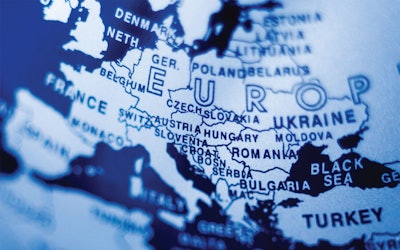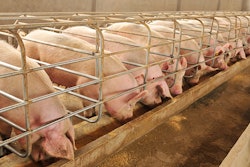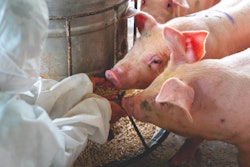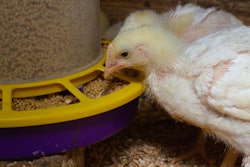
European Union sees slight increase in self-sufficiency, but will likely see a drop next year due to Brexit.
Over the past year, the European Union (EU) achieved a slight increase to 78% in its level of self-sufficiency for proteins in livestock feeds. This figure is forecast to fall to 76% next year after the departure of the United Kingdom (U.K.) from the EU.
Of the total 84 million metric tons (mmt) of protein fed to EU livestock and poultry in the 2019-20 year, 66 mmt originated in the EU. This equates to a self-sufficiency level of 78%, according to the Feed Protein Balance Sheet recently released by the European Commission (EC). These figures include the U.K., and so are directly comparable with previous editions that cover the 28 member states.
Use of feed ingredients in EU feeds
In the Balance Sheet, the EC covers four categories of feed ingredients: crops, co-products, non-plant sources and roughages (forage).
At 1.332 billion metric tons, roughages comprise the bulk of feed requirements in the EU in terms of volume. This includes more than 1 billion metric tons of grass, 247 mmt of corn silage, 65 mmt of fodder legumes, and 1.4 mmt of dried forages.
Over the year 2019-20, 181.7 mmt of crops were incorporated in animal feeds, of which 161 mmt (90%) were of EU origin.
At 176.6 mmt, cereals (grains) account for a high proportion of this category, and provided the same level of self-sufficiency. Of the individual grains, corn, wheat and barley were the most widely used in EU feeds in 2019-20. While most of the wheat and all of the barley were grown in the EU, 74% of the corn was imported into the region.
Other crops used in EU feeds were whole oilseeds (1.6 mmt; all home-grown) and pulses (3.6 mmt; 3.1 mmt of EU origin).
Of the 85.9 mmt of co-products (byproducts) used in European feeds during the study year, 45.3 mmt were produced in the EU. Derived from the starch industry, distilling/ethanol, flour milling and sugar production, 94% of the 33.1 mmt of “other co-products” were produced in the region. However, for oilseed meals — the largest-category of co-products — the EU achieved just 27% self-sufficiency.
Fourth and final category of feed ingredients identified by the EU are the non-plant feed ingredients. Including materials as diverse as food wastes, processed animal proteins, fish meal, whey powder and skim milk powder, the EU produced 8.2 mmt of the 8.4 mmt used in animal feeds in 2019-20.
Contribution to EU feed protein supply
As well as overall volumes, the EC also calculates the contribution of each category and ingredient to the Feed Protein Balance Sheet. Protein figures are calculated on a crude protein basis.
Of the total 84 mmt protein in the region’s feeds in the 2019-20 period, 66 mmt or 78% originated in the EU.
Roughages accounted to 38 mmt of this total, and all was grown in the EU.
In terms of total protein contribution, the second most important category was the co-products. These provided 25.8 mmt of the total protein used in feeds, with 37% originating in the EU. Oilseed meals alone provided 21 mmt protein, including more than 13.5 mmt as soybean meal. In terms of crude protein, just 3% of the soybean meal protein used in the EU was produced within the region. For rapeseed meal and sunflower meal, the levels of self-sufficiency in protein terms were 72% and 52%, respectively.
All crops contributed 18.36 mmt protein in EU feeds, and self-sufficiency was 90%. Of this, 17 mmt was the protein contributed by grains, which were also 90% home-grown. For the individual crops, the EU only imports a significant amount — 26% — of its corn protein needs. All of the region’s whole oilseed requirements are grown within the EU. For pulses, 13% in protein terms is imported.
Non-plant ingredients supplied 2.16 mmt crude protein to animal feeds in the study year. Of this total, 2.04 mmt or 94% originated in the EU. This included all the former foodstuffs, whey powder, and skimmed milk powder used, and most of the fish meal and processed animal proteins.
Recent trends in EU feed formulations
For the previous year 2018-19, home-grown ingredients accounted for 77% of the 82 mmt of crude protein in EU livestock feeds.
Overall, there have been few dramatic changes for the current 2019-20 Balance Sheet compared with the previous year. However, the increase in the volume of roughages fed is noteworthy — 1.332 billion metric tons in the current report. This compares with 1.249 billion metric tons the previous year.
Furthermore, the volume of all crops used in EU feeds was also higher than the previous year. This amounted to 161 mmt, compared with 153.5 mmt in 2018-19. Most of this difference can be attributed to the increased use of grains. However, the use of EU-origin pulses rose to 3.1 mmt in 2019-20 from 2.6 mmt the previous year. Although small in volume, the amounts of field peas, broad beans and lupins used were all higher year-on-year.
Commenting on the latest figures, the EC highlighted a shortage of locally produced meal in 2019-20. In the latest report, 9 mmt of EU-origin rapeseed meal was incorporated in feeds. For the previous year, the corresponding figure was 10.5 mmt.
In an earlier study for 2017-18, the EU was calculated to be close to 80% self-sufficient in crude protein for livestock feeds on a total use of 85 mmt.
Forecasts for 2021
In preparation for the U.K.’s final exit from the EU in January, the EC has also published an EU Feed Protein Balance Sheet for the remaining 27 member states for 2020-21.
As feed production contracts, there will likely be a corresponding reduction in the EU’s total feed protein requirement. This is forecast at 73 mmt — 11 mmt less than the latest figure for 2019-20 including the U.K. With 56 mmt of this total originating in the EU, the level of self-sufficiency is forecast to fall by two percentage points to 76%. EC attributes most of this change to the relatively high contribution of U.K. forage production.
Furthermore, according to the EC, demand will be lower for compound feeds in the coming year. As a result, requirements for grains and oilseeds by EU feed producers are also forecast to be lower. However, EC expects increases of 6.5% in corn silage and 4.6% in forage legumes production for the year ahead.









